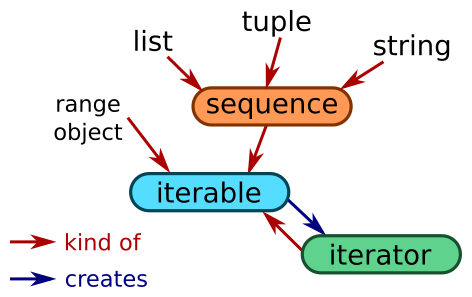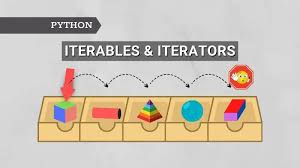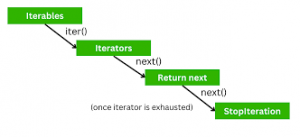
In Python iterator vs iterable, may sound similar, but understanding their differences is crucial for effective Python programming. Iterables are the data structures you loop over, while iterators are the objects that facilitate this process. Python’s for loop simplifies iteration, creating and managing iterators behind the scenes.
It’s important to note that many built-in functions and constructs in Python, such as forloops, sum(), len(), andsorted(), can work with any iterable, regardless of its specific type. This allows for flexibility and consistency when working with different types of data structures in Python.
Difference between iterator, iterable, and iteration in Python

The difference between Python iterator vs iterable and iteration: An iterable is a collection of data that can be looped over, an iterator is an object that keeps track of the current position during iteration, and iteration is the act of looping over an iterable to access and process its elements. Python’s for-in loop simplifies the process by abstracting the details of creating and managing iterators.
- Iterable: An iterable is an object or data structure that can be iterated over or looped over. It can be a list, tuple, string, dictionary, or any collection type. Iterables have a
__iter__()method that returns an iterator. - Iterator: An iterator is an object representing a stream of data to be traversed. It implements two methods:
__iter__()and__next__(). The__iter__()method returns the iterator object itself and__next__()returns the next value in the sequence. When there are no more items to return, it raises anStopIterationexception. - Iteration: Iteration is the process of repeatedly applying an operation to a sequence of elements. It’s achieved using a loop or for-in construct. When you loop over an iterable (e.g., a list) using a for loop, you are performing an iteration. The for loop automatically handles the creation of an iterator, fetching values from it, and catching the
StopIterationexception when the end is reached.
What are iterators in Python?
In Python compared to iterator vs iterable, iterators are objects that implement the iterator protocol, which consists of two methods: __iter__() and __next__().
The __iter__() method returns the iterator object itself and is responsible for initializing or resetting the iterator’s state.
The __next__() method returns the next item in the iteration sequence. If there are no more items, it raises the StopIteration exception to signal the end of the iteration.
Iterators can be used to traverse and access elements of an iterable object, such as lists, tuples, strings, or custom-defined objects. They allow for lazy evaluation, meaning that they generate the next item only when requested, which can be memory-efficient for large or infinite sequences.
Python provides built-in iterators like range(), enumerate(), and zip(), and you can also create your own custom iterators by defining classes that implement the iterator protocol.
The for-in loop in Python internally uses iterators to iterate over an iterable without explicitly dealing with the iterator object or the __next__() method.
What is an iterator in one line: An iterator is an object in Python that implements the iterator protocol, providing the
__iter__()and__next__()methods. It allows for sequential access to elements of a collection or sequence.

In Python, compared to iterator vs iterable: An iterable is an object that can be looped over. It represents a collection of items or elements.
Iterables can be used in various looping constructs, such as for loops, list comprehensions, and generator expressions. They allow you to access each element in the collection one by one.
Common examples of built-in iterables in Python include lists, tuples, strings, dictionaries, sets, and files. These objects have a defined sequence or structure, and you can iterate over their elements.
Additionally, some built-in functions and classes in Python return or work with iterables. For example, the range() the function returns an iterable sequence of numbers, the enumerate() function returns an iterable that provides both the index and value of each element and the zip() the function returns an iterable that combines elements from multiple iterables.
It’s also possible to create custom iterables by defining classes that implement the iterator protocol, which involves defining the __iter__() method that returns an iterator object.
Overall, the summary of iterator vs iterable, iterable is any object in Python that can be looped over to access its elements sequentially.
What does iterate mean in Python?
To iterate means to repeat a process or operation multiple times, typically in a sequential manner. In the context of programming and data processing, iteration refers to the act of repeatedly performing a set of instructions or accessing elements in a collection, such as a list or array.
When you iterate over a collection, you traverse through its elements one by one, often using a loop construct like a for loop or a while loop. Each iteration allows you to perform specific operations on the current element or update the iteration state to move to the next element.
Compared to iterator vs iterable, the process of iteration involves executing a block of code or operation for each item in the collection until a certain condition is met or until all the elements have been processed. This allows you to perform tasks like data manipulation, computation, filtering, or transformation on each element of the collection.
Iteration is a fundamental concept in programming and is widely used to process data, perform calculations, and control the flow of execution in loops and algorithms.
What is iteration in Python?
Compared to iterator vs iterable, iteration in Python refers to the process of repeatedly executing a block of code or performing a set of operations for each item in a collection or sequence. It involves iterating over an iterable object, such as a list, tuple, string, or iterator, to access and process its elements one by one. Iteration is commonly achieved using loop constructs like for loops or while loops. It allows for tasks such as data manipulation, calculations, filtering, or transformation to be performed on each element during the iteration process.
Python Iterator vs Iterable: Understanding the Key Differences
Python’s iterator and iterable are fundamental concepts in the language, often confused due to their closely related names. An iterable is any Python object capable of returning its elements one at a time. An iterator, on the other hand, is an object used to traverse through an iterable.
Why use iterator in Python?
Why use iterables in Python?
The Process of Iteration (iterator vs iterable)
Iteration, in Python, is the process of looping over an iterable to access and process its elements. Python’s for-in loop automatically manages the creation of an iterator, fetching values, and catching the StopIteration exception when the end of the iterable is reached.
Key Differences at a Glance
iterator vs iterable:
- Iterable: Can be looped over and has an
__iter__()method. - Iterator: Used to traverse elements within an iterable, with
__iter__()and__next__()methods. - Iteration: The act of looping over an iterable to access and process its elements.
Relationship:
-
- Every iterator is an iterable, but not every iterable is an iterator.
- An iterable can produce multiple independent iterators.
- Iterators maintain their internal state during iteration, allowing them to remember the progress and return to the next element.
Understanding these distinctions, iterator vs iterable is crucial for effective Python programming. Iterables provide a source of data, while iterators provide a mechanism for traversing that data sequentially.
Benefits Python iterator vs iterable

Iterators and iterables serve distinct purposes in Python, each offering its own benefits:
Benefits of Iterators:
- Lazy Evaluation: Iterators use lazy evaluation, meaning they generate and provide values on-demand. This is memory-efficient as it doesn’t load the entire dataset into memory at once, making them suitable for working with large or infinite sequences.
- Custom Iteration Logic: You can implement custom iteration logic in iterators by defining the
__next__()method. This allows you to control the sequence and processing of elements as you traverse through the data. - Stateful Iteration: Iterators can maintain state information during iteration. This is useful for cases where you need to remember the position or status within the iteration, such as in parsing or streaming data.
- Support for Multiple Iterations: Iterators allow multiple independent iterations over the same iterable without interference. Each iterator retains its position, which is beneficial in scenarios where parallel or nested iterations are required.
Benefits of Iterables:
iterator vs iterable
- Simplicity: Iterables provide a more straightforward and user-friendly way to loop over data structures like lists, strings, and dictionaries. They don’t require explicit implementation of the
__next__()method. - Readability: Using iterables with
forloops enhances the readability of your code. It’s a common and intuitive way to access elements within a collection. - Common Usage: Many built-in Python functions and libraries, like
forloops and list comprehensions, work seamlessly with iterables. This makes them convenient and widely applicable in Python programming. - Compatibility: Iterables are used in a majority of Python code, and they are generally compatible with various Python constructs and libraries, making them a standard choice for most situations.
In practice the summary of iterator vs iterable, the choice between iterators and iterables depends on your specific use case and the trade-offs between memory efficiency, customization, and readability. Python’s versatility allows you to select the appropriate approach based on your programming needs.
Use Cases and Benefits of Iterators (iterator vs iterable)
Compared to iterator vs iterable, iterators offer benefits such as memory efficiency, improved performance, custom sequence generation, simplified code logic, compatibility with looping constructs and built-in functions, and support for infinite sequences and dynamic data streams. By leveraging iterators in your Python code, you can optimize memory usage, achieve more flexibility, enhance code readability, and efficiently handle various types of data.
Use Cases and Benefits of iterable:
Overall, compared to iterator vs iterable, iterables offer benefits such as easy iteration, compatibility with built-in functions, flexibility in handling different data structures, improved code readability, support for custom-defined iterables, and integration with various libraries and frameworks. By utilizing iterables, you can write more expressive, modular, and interoperable code for efficient data processing and manipulation in Python.
Types of Python iterator and iterable?
In Python, compared to iterator vs iterable, there are several types of iterators and iterables. Let’s explore them:
Types of Iterators:
- List Iterator: It allows iterating over elements of a list sequentially.
- Tuple Iterator: It enables sequential access to elements of a tuple.
- String Iterator: It allows iterating over characters in a string.
- Dictionary Iterator: It provides iteration over keys in a dictionary.
- File Iterator: It allows reading a file line by line or character by character.
- Range Iterator: It generates a sequence of numbers within a specified range.
- Custom Iterator: It is a user-defined iterator created by implementing the
__iter__()and__next__()methods.
Types of Iterables: iterator vs iterable
- Lists: Lists in Python are iterable, allowing you to iterate over each element in the list.
- Tuples: Similar to lists, tuples are iterables that can be looped over.
- Strings: Strings are also iterable, allowing you to iterate over characters in the string.
- Dictionaries: In Python, dictionaries are iterable over their keys, which can be accessed one by one.
- Sets: Sets are iterables that provide access to each element in the set.
- Files: When reading a file, it is iterable line by line or character by character.
- Custom Iterables: You can create your own iterables by implementing the
__iter__()method in a custom class.

Iterators in Java provide sequential access, safe removal, fail-fast behavior, and efficient memory usage. They allow you to traverse elements one by one, remove elements safely, detect concurrent modifications, and conserve memory by lazily generating elements.
On the other hand, iterables in Java offer enhanced iteration convenience, compatibility with the enhanced for loop, encapsulation of data and behavior, and integration with utility methods. They simplify iteration using the for-each loop, promote code readability and modularity, and enable the use of utility methods like forEach(), stream(), and spliterator().
The summary of iterator vs iterable, iterators provide fine-grained control over iteration and memory efficiency, while iterables offer convenience, compatibility, encapsulation, and integration with utility methods. Both concepts are valuable in Java for efficient and convenient data manipulation and traversal.
The best example of iterator vs iterable:
An iterable, like a list, is a collection of data that can be looped over directly with a
forloop. An iterator, such as a generator, is an object with custom-defined iteration behavior, allowing control over the sequence of values, supporting lazy evaluation, and conserving memory. Iterables are simple, while iterators offer customization and efficiency. (Title: Python iterator vs iterable: iteration | iterate | Best Examples)
See Also:
- How to find a np transpose matrix in Python
- Numpy Transpose Matrix in Python:
- Python Classes and Objects Exercises for Beginners
- Functional Programming vs OOP: Best Comparison
- Python Inheritance Constructor | Super | Override | Init
- Using Python Lamda if else | elif | function | syntex
- How to Convert Python JSON to CSV using Python Libraries
- What does Numpy Arange do | np.arange
- How Many Data Types in Python with examples




